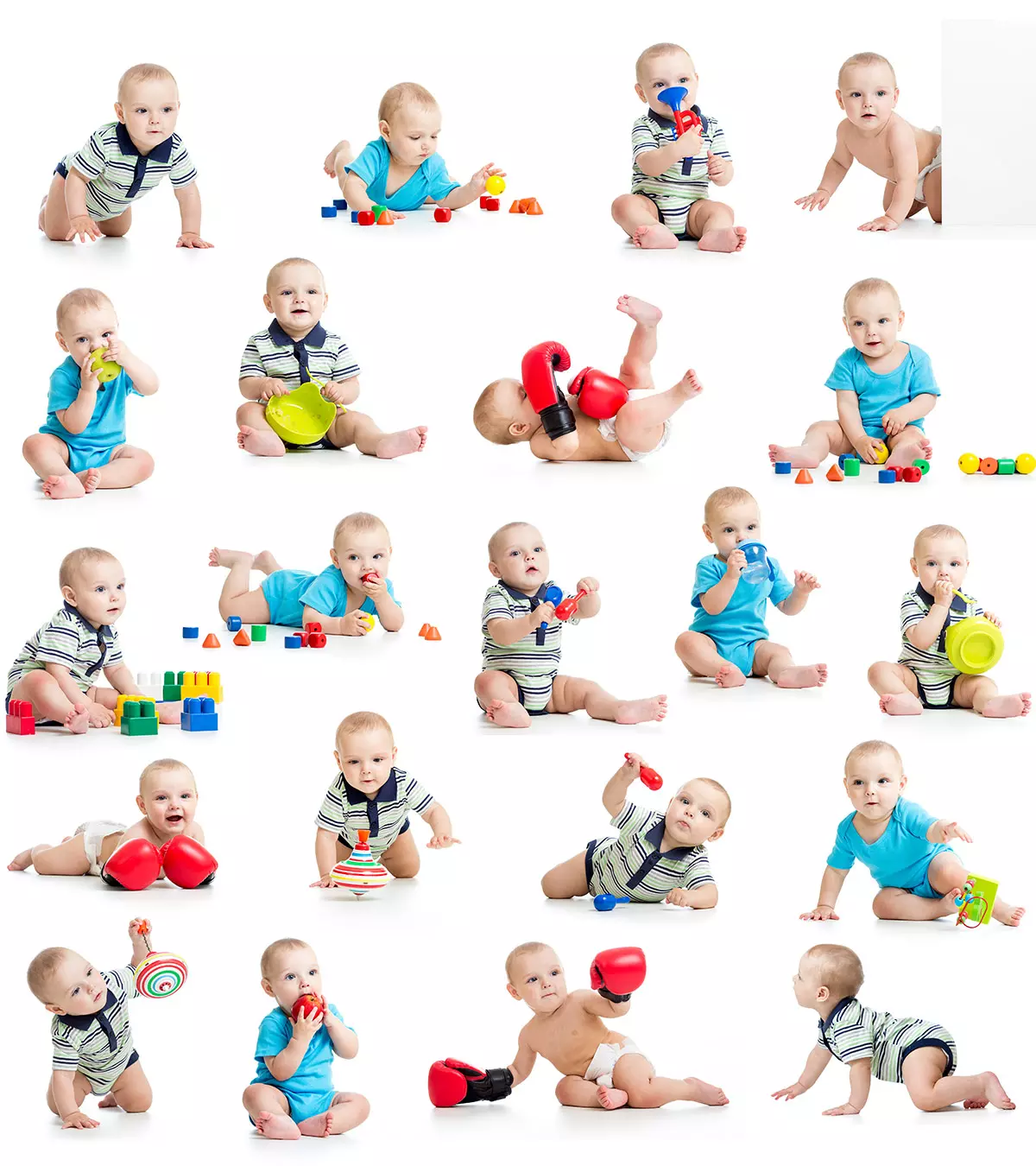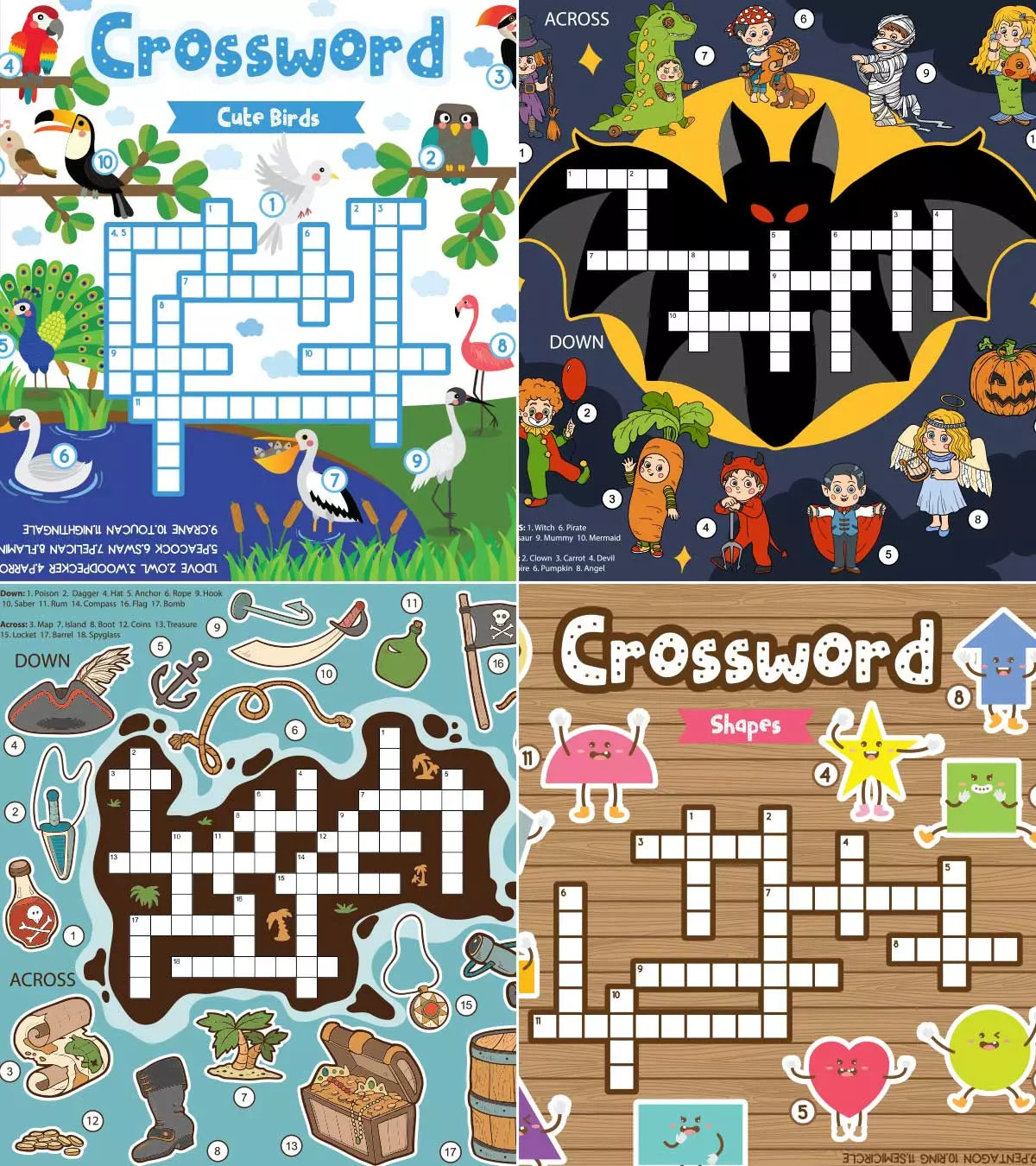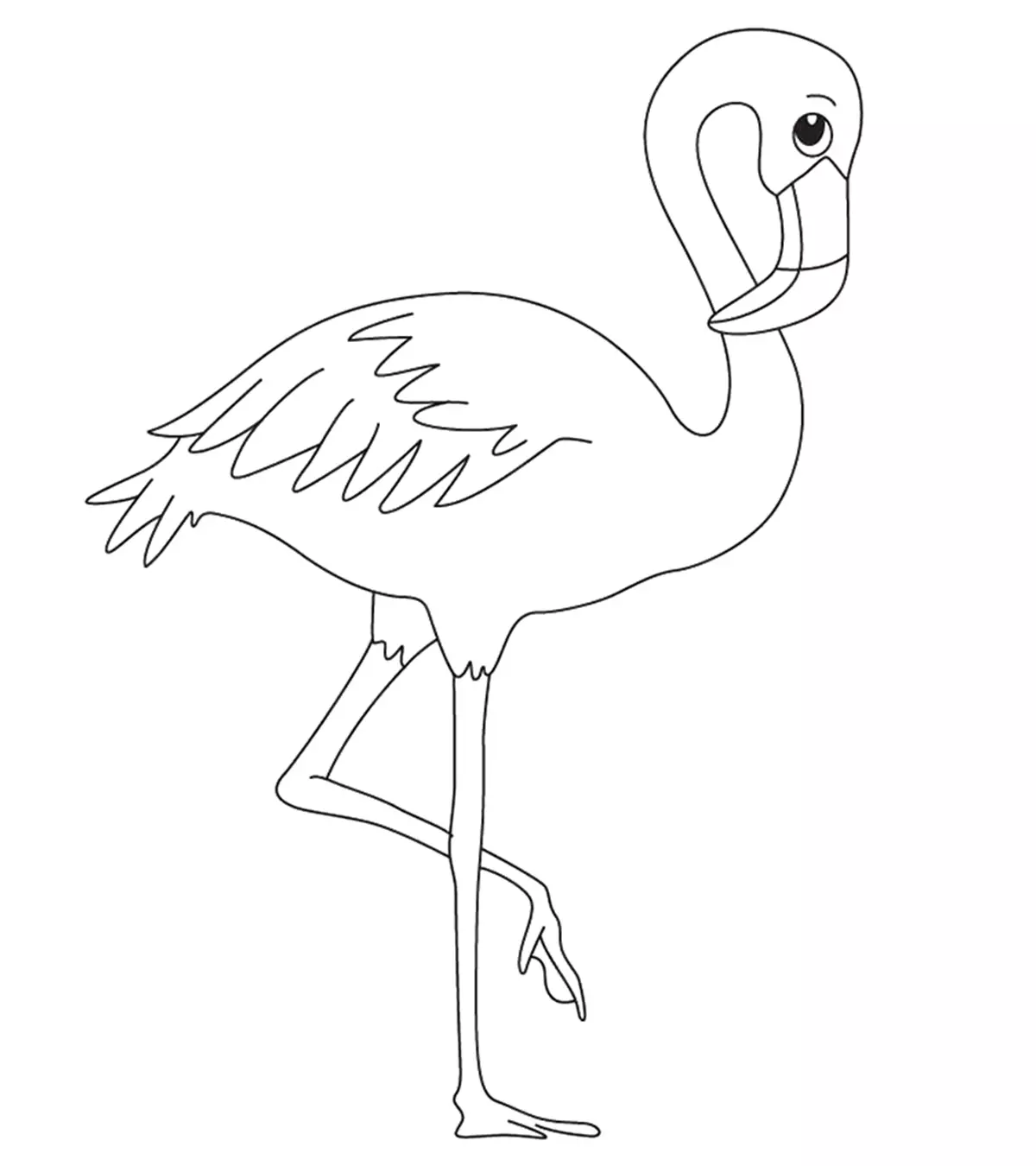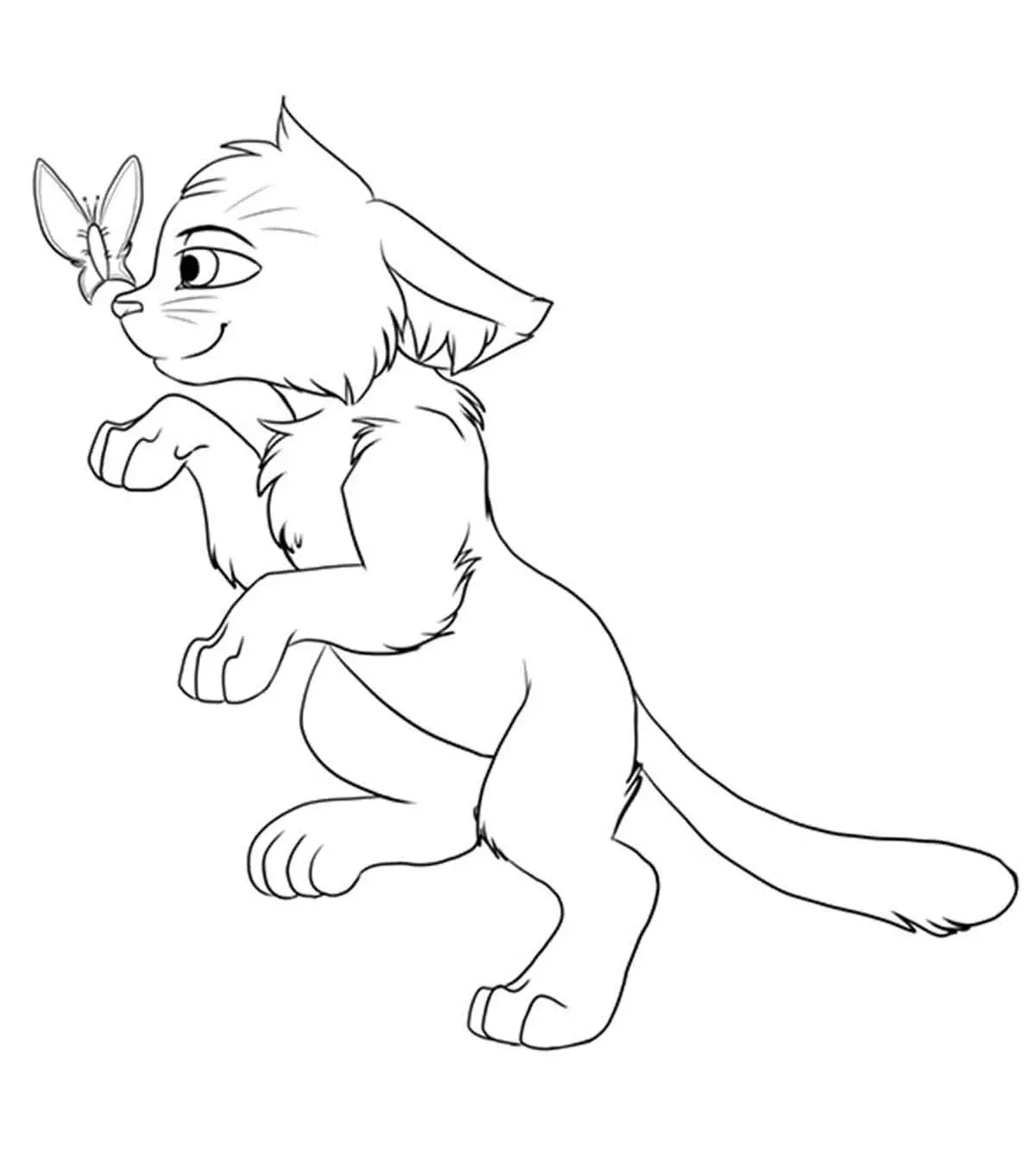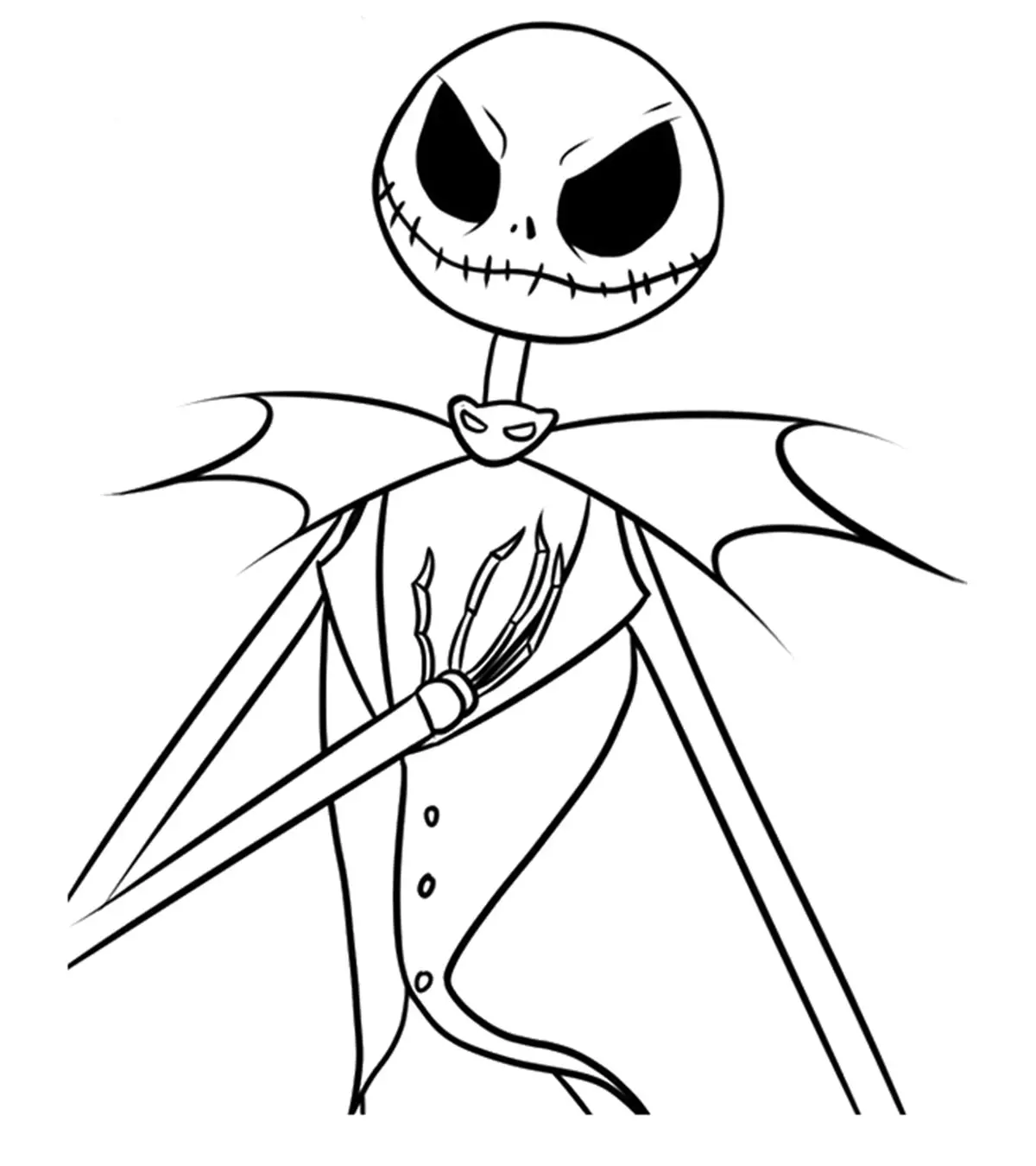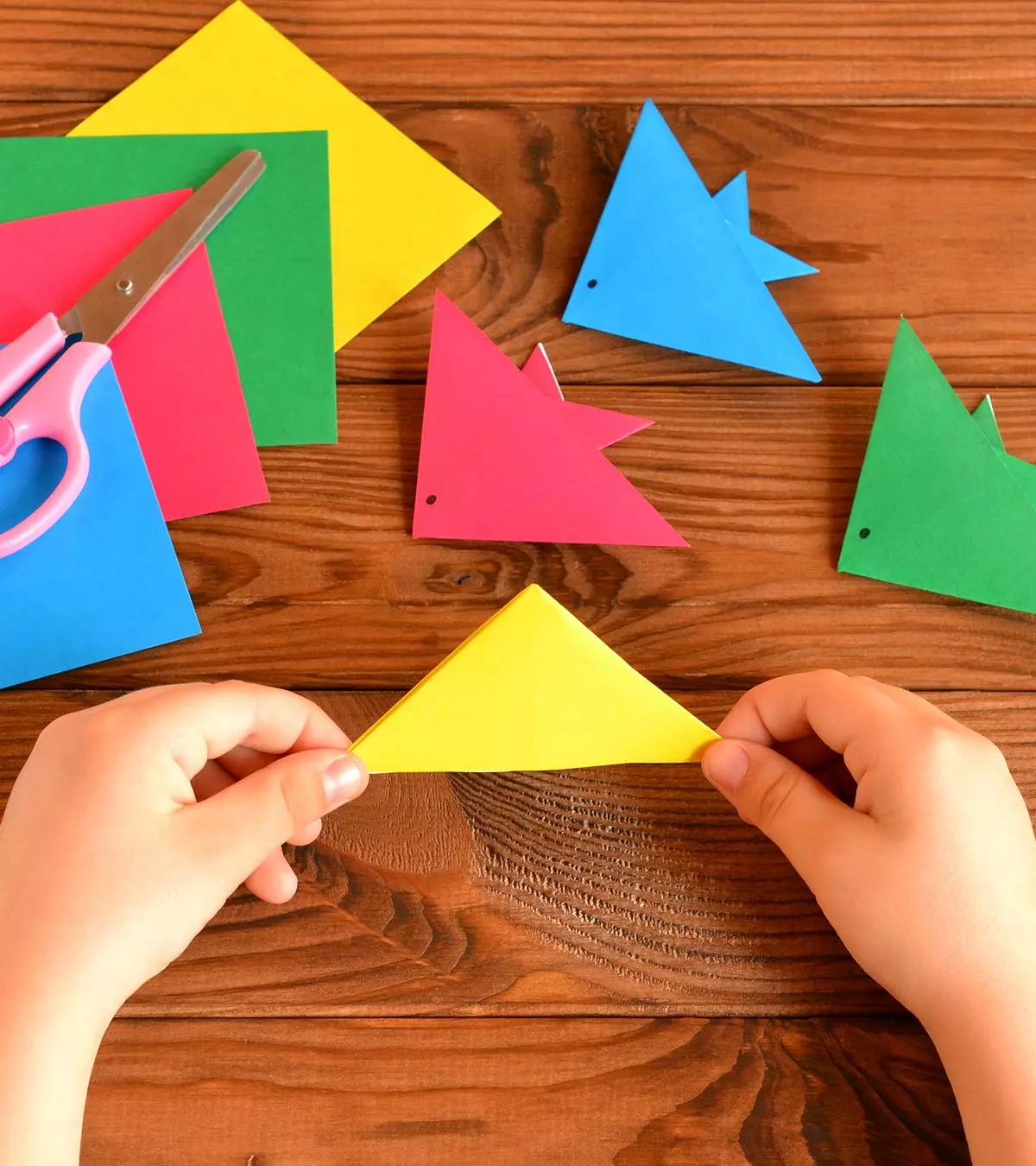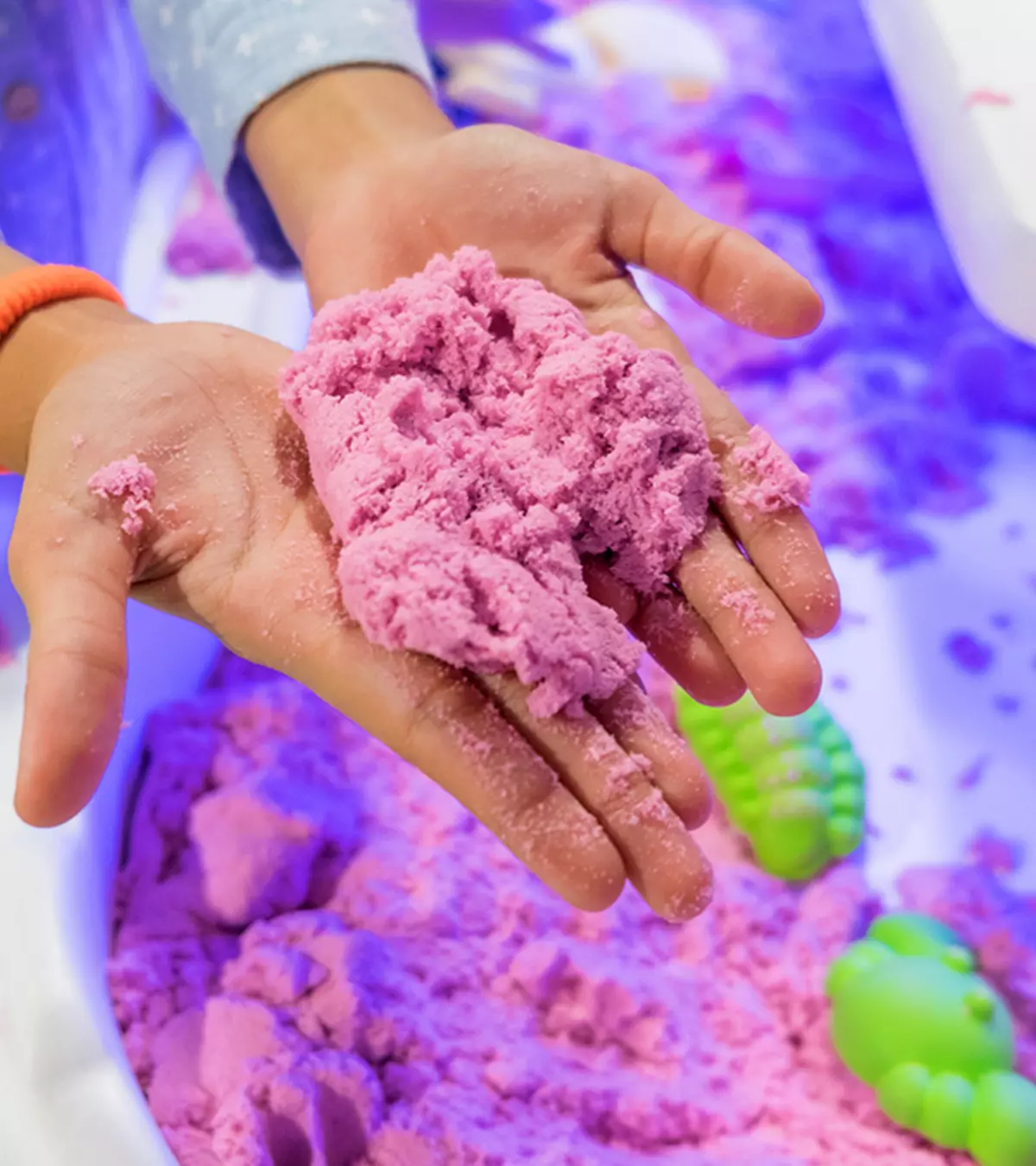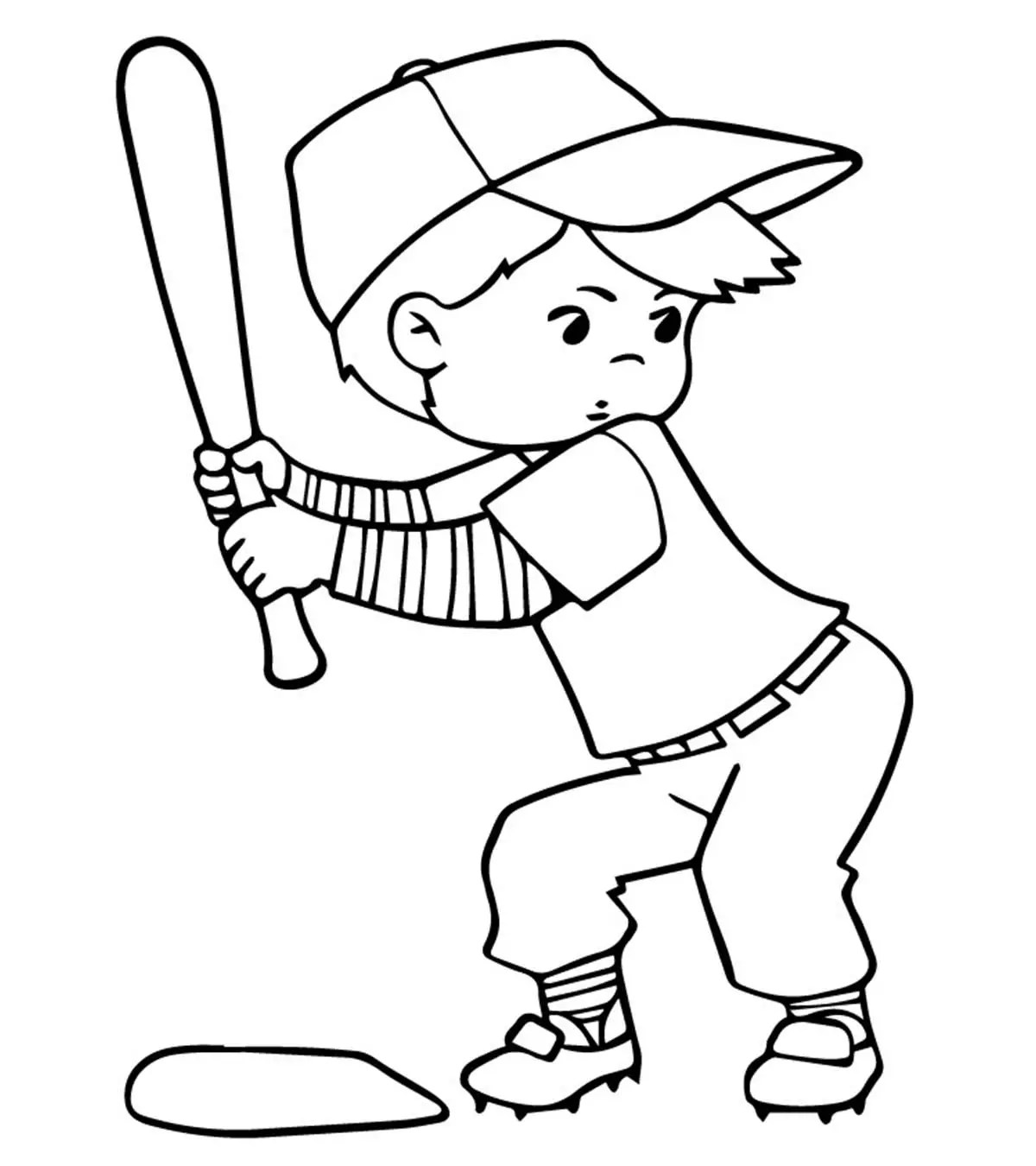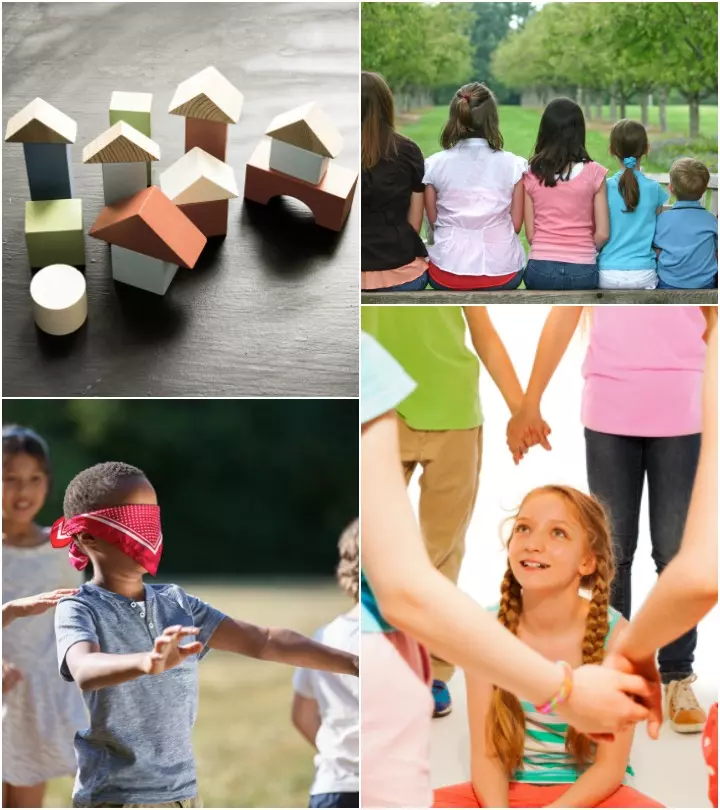
Image: MomJunction Design Team
Mattie J T Stepanek once said that unity is strength…when there is teamwork and collaboration, wonderful things can be achieved. Summer is the perfect time to introduce team building activities to kids. These activities help them develop crucial skills. Team building activities for kids are known to teach them life skills that will have a lasting impact in the long run. Whether it is a football game or an orchestra, things can go wrong if the participants are not in sync. When you are teaching team building games, it means you are teaching your child how to succeed as a team. A study reveals that teamwork is a core skill needed for succeeding in the classroom and workplace (1). Here are some team building activities that children can try out at home or at school to keep them engaged during the vacation.
Key Pointers
- Keep the materials, such as an A4 sheet, pencil, eraser, sharpener, stencil, and ruler, handy for your convenience.
- Start with the most basic and easy design first. Once your child has mastered the easy drawings, move on to the complicated designs.
- Before adding new specifications to the car, practice drawing them separately.
45+ Team Building Activities For Kids
Team building activities are good work for the little ones’ gray cells. They encourage children to find ways to work with each other to achieve a common goal (2). Teamwork helps kids communicate with others, increases their social skills and self-confidence, and helps them develop into happier adults. Whether at home or school, children should learn to be a part of a team of different people. While it is normal for children to feel anxious in the beginning (known as the forming stage), they can learn about each other and set boundaries and expectations through an activity (3). There are several activities that you can use to teach kids about teamwork. We bring you our list of effective team building games and exercises for kids.
Let’s start with fun games.
Fun Team Building Games For Kids
Games are fun. One of the most effective ways to teach your child something is through play (4). Different team building activities can allow children to know each other and encourage bonding among group members (5). This is our list of fun team games for kids they would love to play.
1. Picture Pieces

Picture Pieces combines the fun of drawing and working together as a team. This puzzle solving game is best played indoors and is considered to be one of the most entertaining team building activities for kids.
How it helps:
Teaches kids how ‘departmental working’ and how important teamwork is to achieve the desired result.
Materials:
- A popular cartoon strip or an image that the children can reproduce on paper. The complexity of the diagram should depend on the age-group of the kids.
- Pencils
- Paper
Number of participants:
Six to eight
Time required: 30 minutes
Instructions:
- Cut the picture you have selected into six or eight equal squares. Cut the image in such a way that when you join the pieces, the entire picture is in place.
- Give each child a picture and ask him or her to reproduce a copy of the image.
- After 20 minutes, ask the children to bring their drawings together and join them to see if they are able to recreate the picture.
- They can make changes to their work if needed, for a final reproduction as accurate as the original one.
Tips to the facilitator:
Give the children papers with squares of the same sizes to draw on each. Ask the children to draw the piece of their puzzle within the box. This will ensure that the images are consistent in size.
2. Caterpillar Race
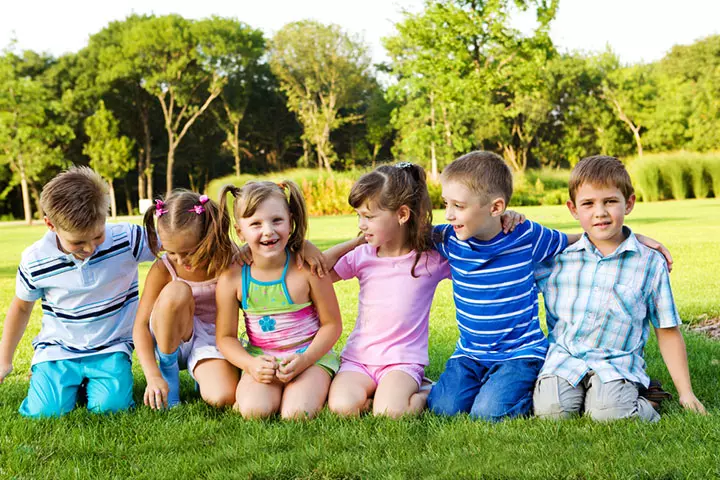
This outdoor team-building activity combines physical activity with teamwork in a fun and engaging way.
How it helps:
Encourages cooperation and coordination as kids work together to move as a unit.
Materials:
- An obstacle-free and safe area for kids to play.
Number of participants:
12 or more
Time required: 15-20 minutes
Instructions:
- Draw a starting line and a finish line.
- Divide the class into teams of four to ten children each.
- Ask each of the teams to line up one by one and ask every child to put their hand on the shoulders of the child in front of them.
- On the count of three, everyone crouches down into a caterpillar position, making sure not to lose contact with the shoulders in front of them.
- At ‘Go!’ the teams begin moving toward the finish line while maintaining their caterpillar formation. The first team to cross the finish line while staying connected wins.
Tips to the facilitator:
Encourage the children to talk to each other to coordinate their body movements and maintain their formation. Ensure the race area is safe and clear of obstacles to help prevent any accidents.
3. Sneak A Peek
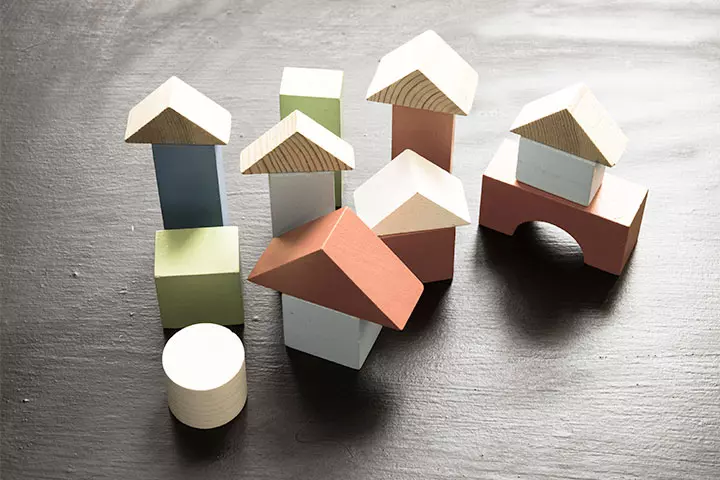
This game is about memory and recreation of something as a team and it is best played indoors.
How it helps:
The game focuses on communication between team members. It also teaches them to be open to other people’s perception.
Materials:
- Building blocks – you will need as many sets as the number of teams
- Space for kids to work
Number of participants:
Three or four teams of four kids each
Time required: 15 minutes
Instructions:
- Create a structure using building blocks, without the kids seeing it – you can do it in another room and bring it to the kids.
- Give each team one set of blocks. Show the structure you have created.
- One person from each team comes and takes a peek at the structure – they have ten seconds to look at it and memorize it.
- The team member will have to explain the structure to the others so that they can recreate it.
- If they don’t get it right, another member from the team can go and take a peek at the structure and go back to helping the others.
Tips to the facilitator:
Create a simple and easy figure for the kids to understand and replicate by observation and comprehension of design.
 Quick fact
Quick fact4. Cup Stacking Challenge

Ideal for middle and high school students, this exercise is a fun way to foster collaboration among children. This activity is enjoyable when played indoors.
How it helps:
It helps enhance teamwork, develop leadership and delegation skills, and improve communication, negotiation, and critical thinking.
Materials:
- 6 paper cups per team
- 1 rubber band per team
- 5 pieces of string per team
Number of participants:
10 or more
Time required: 10 minutes
Instructions:
- Split the group into teams of five students each. Provide each team with the necessary materials.
- Each participant ties their string to the rubber band, creating a tool for manipulating the cups.
- Using only the strings and rubber band, teams must stack the cups into a pyramid structure with three cups on the bottom, two in the middle, and one on top. They are not allowed to touch the cups directly with their hands.
- Start the timer and observe as they work together to achieve their goal.
Tips to the facilitator:
To ensure smooth facilitation, observe each group closely and offer hints if they struggle with using the rubber band and strings.
5. Classification

Classification is one of the amazing icebreaker games that helps them understand and accept the differences between different people. This is one of the interesting kids’ team building games that can be best played indoors.
How it helps:
This game teaches the kids to classify or make groups of people without any kind of stereotyping, discrimination, or such negative aspects.
Materials: Space for kids to play
Number of participants: 12 or more
Time required: 15 minutes
Instructions:
- Divide the kids into two or three groups.
- Ask the children to tell the others about themselves – their likes, dislikes, dreams, goals, etc.
- Ask them to classify the team into sub-groups based on the information they shared. Groups could be based on the foods, colors, or movies they like, etc.
- By the end of the game – children will know what their friends like and that a team can be made up different kinds of people.
Tips to the facilitator:
Explain the concept of stereotyping – the kids should not use any kind negative judgments or prejudice when creating the sub-groups.
6. Marble Run Challenge
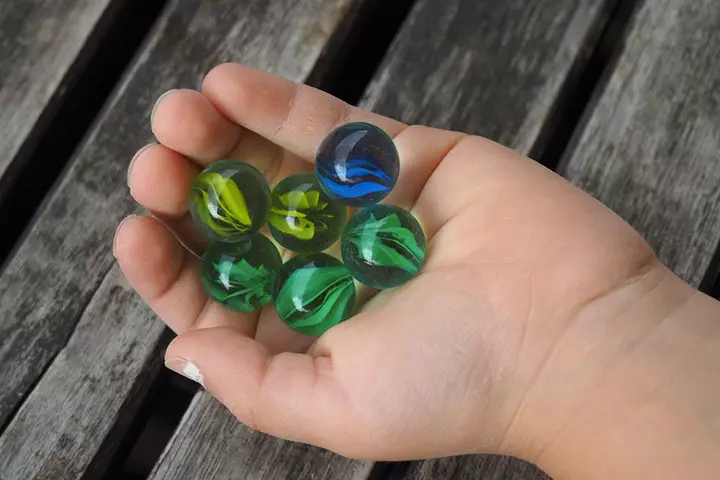
Marble Run Challenge has kids design and build a track to transport a marble from start to finish. This activity is ideal indoors.
How it helps:
Enhances creativity, engineering skills, and teamwork as kids design and test their marble runs.
Materials:
- Marbles
- Cardboard
- Tubes
- Tape
- Other crafting materials
- Scissors
Number of participants:
6 or more
Time required: 20-30 minutes
Instructions:
- Provide each team with materials and a marble.
- Set the challenge to create a marble run that transports the marble from the starting point to an endpoint within a set time frame.
- Compare the designs by timing the marble’s travel from start to finish.
Tips to the facilitator:
Provide suggestions on structural integrity and creativity but let them lead the project.
7. Go!
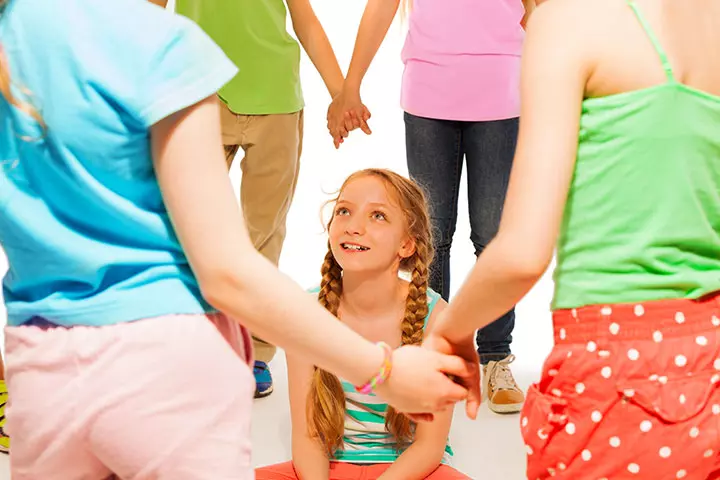
Go is a fun game that teaches children about non-verbal communication, especially eye-contact while working together. It can be played indoors or outdoors.
How it helps:
Go helps children to learn about non-verbal cues and to stay alert.
Materials: Space for the kids to play
Number of participants: 12 to 15
Time required: 15 minutes
Instructions:
- Ask the kids to stand in a circle. Pick a volunteer to be ‘1’, who starts the game.
- ‘1’ makes eye-contact with one player (say 2) in the circle, and indicates them to say ‘go’. Once she receives the command, 1 slowly moves towards the person.
- In the meanwhile, ‘2’ has to make eye-contact with another player (3) who has to say ‘go’ in time to let 2 vacate her spot for 1.
- The players have to continue the game this way, until all of them have changed places.
Tips to the facilitator:
The idea of the game is to time the commands such that each player makes space for the others in time. The best way to explain this game is by demonstration.
8. Mystery Bag Skits

Mystery Bag Skits is a creative activity where kids use random props from a bag to perform a skit. This activity is best performed indoors.
How it helps:
Boosts creativity, improvisation, and teamwork as kids create and perform a skit based on given props.
Materials:
- Bags with various random props (e.g., hats, toys, umbrellas, utensils)
Number of participants:
6 or more
Time required: 15 minutes
Instructions:
- Fill each bag with a variety of props and distribute them to the teams.
- Allow teams a few minutes to plan a skit using the items in their bag.
- Each team performs their skit for the group.
Tips to the facilitator:
Providing a theme or setting for the skit might be helpful to guide them in the creative process.
9. Group Juggle

This is a fun team challenge game that little kids will enjoy. It can be played by older kids and teens too.
How it helps:
Group challenges help children coordinate better with one another and improve their motor coordination skills as well.
Materials:
- 10-15 Lightweight balls
- This game can be played indoors (room with a high ceiling) or outdoors.
Number of participants:
Ten
Time required: 10 minutes
Instructions:
- Divide the kids into two groups of five each.
- The groups stand in a circle, facing each other. Give them the balls and ask them to juggle them in a specific order.
- Start with two juggling balls and introduce more slowly – this makes the activity more challenging for the group.
- The group that can juggle the balls for the longest time, without dropping them, wins.
Tips to the facilitator:
Use lightweight balls or soft balls to prevent injuries to the kids.
10. Hula Hoop Challenge
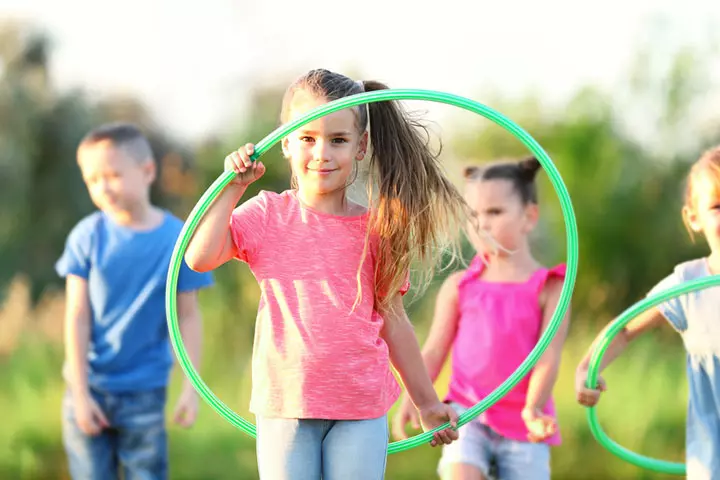
Perfect for a group setting, this game requires only a hula hoop and can be played both indoors and outdoors. It can be a great summer camp activity for kids.
How it helps:
Kids get to learn the importance of coordination, teamwork, and communication for completing the assigned task.
Materials:
- 1 hula hoop per group
Number of participants:
10 or more
Time required: 10 minutes
Instructions:
- Group the kids into sets, with each group containing four or five members.
- Arrange the children in a circle within their groups. Each child should extend their arms and hold out their hands with their index fingers pointing up.
- Place a hula hoop on the extended index fingers of each group. Make sure it is level and resting gently on their fingertips.
- The goal is to lower the hula hoop to the ground without letting it drop or anyone hooking their fingers around it.
- If the hula hoop falls or someone loses contact, the group must restart.
- The activity concludes when the first team successfully lowers the hula hoop to the ground or when the time runs out.
Tips to the facilitator:
Watch closely to ensure that no one hooks their fingers around the hula hoop.
11. Tallest Tower
Tallest tower challenges kids to build the tallest possible tower they can with whatever is available around them. This game can be played indoors.
How it helps:
This game encourages the children to get creative in what they use to make their tower the tallest.
Materials:
- Books
- Tins
- Blocks
Anything else that is unbreakable can be used in building the tower.
Number of participants: 15
Time required: 15 minutes
Instructions:
- Divide the children into three groups of five each.
- Give them the needed material for building their tower – they could also use other items in the room, with your permission, to complete their tower.
- On ‘go’, the teams start building a freestanding tower with the material.
- Give them ten minutes to complete the tower.
- The team that finishes the tallest tower first wins.
Tips to the facilitator:
Make sure there is ample space for the tower. Also use unbreakable materials for building the tower.
12. Seeing Dots

Seeing Dots is a silent game where students work together to find their teammates by identifying the colored sticker on their forehead.
How it helps:
This game fosters cooperation, observational skills, and teamwork among kids, helping them understand the significance of non-verbal communication.
Materials:
- Colored sticker dots (blue, red, green, or yellow)
Number of participants:
10 or more
Time required: 15 minutes
Instructions:
- Without letting the students see, place a colored sticker dot on each child’s forehead. Ensure that the children do not know the color of their own dots.
- At the start of the game, students must find others with the same color dot as theirs, forming teams. They must do this without speaking.
- The activity concludes when all the students have found their respective groups.
Tips to the facilitator:
To make the game more manageable, consider using fewer colors for younger children. Ensure clear boundaries for the play area to keep students within view.
13. Don’t Wake The Dragon
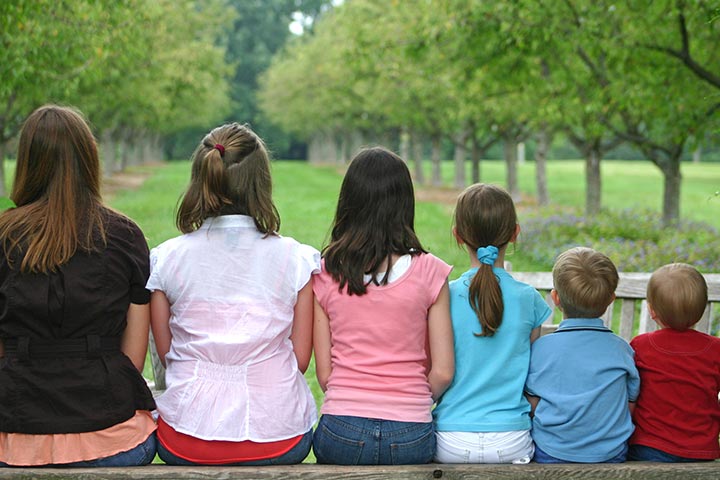
With the fun element of ‘pretend’, this is an interesting team-building game for kids. This game can be played indoors or outdoors.
How it helps:
Don’t wake the dragon encourages kids to use their imagination to solve an imaginary problem.
Materials: Space to play
Number of participants: 12
Time required: 15 minutes
Instructions:
- The kids have to pretend that they are all residents of a village captured by a dragon, which is currently sleeping.
- The kids can cross the village in order of their height.
- The challenge is that the kids have to arrange themselves according to their heights without talking to each other.
- Once the kids think they are standing in the right order, they have to shout “Boo!” at the dragon and see if it works.
Tips to the facilitator:
The facilitator can be the dragon who decides if the order is right and the children can cross the village.
Be it indoor or outdoor activities, sports games for kids makes them energetic and active all the time.
Team Building Exercises For Kids
Some of these team-building exercises focus on certain skills like communication, cooperation, creative thinking, strategizing, etc.
14. Balloon Wars
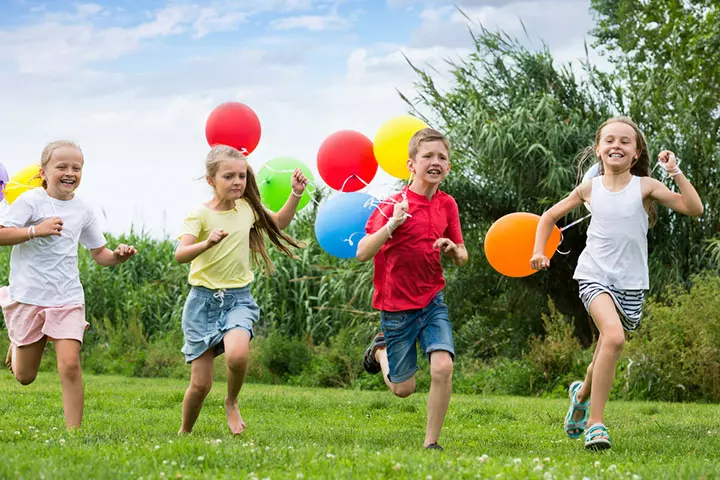
This activity is best enjoyed outdoors, promoting fun, teamwork, and friendly competition. It follows rules similar to football but with a balloon instead of a ball. Players use their hands to hit the balloon across the opposing team’s goal line.
How it helps:
This physical activity helps improve coordination skills and fosters a sense of sportsmanship.
Materials Needed:
- Balloons
- Whistle for signaling substitutions
- Open space for gameplay
Number of participants
: 10
Time required: 10 minutes for a round
Instructions:
- Divide the players into two teams containing 5 members each and designate goal lines for each team.
- 5 members of each team have to present on the field at a time. Start the game by blowing the whistle.
- Players use their hands to bat the balloon over the opposing team’s goal line to score points.
- Rotate players periodically to allow everyone equal participation.
- The game continues until one team reaches 10 points.
Tips to the facilitator:
Ensure safety measures are in place to help prevent any accidents during gameplay. The game can be made more interesting by including age-appropriate obstacles or by expanding the game area.
15. Just Listen
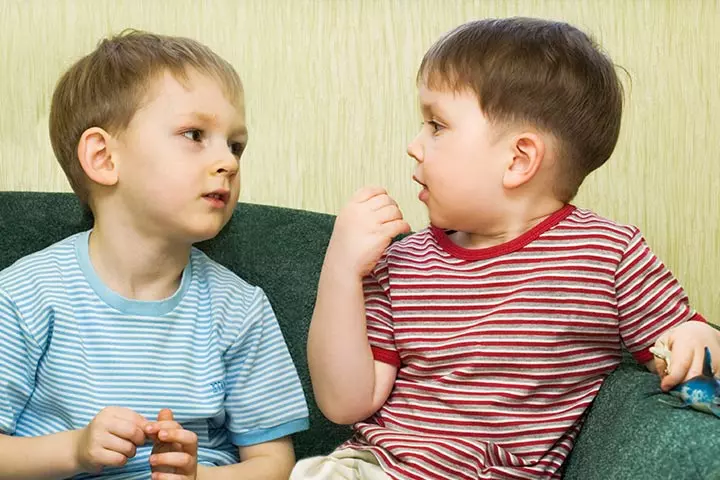
Just Listen is an activity that encourages kids to listen without interrupting or judging. This game is best played indoors.
How it helps:
Encourages listening, comprehending, and accepting another person’s view.
Materials:
- Index cards with different topics
- Space to sit
Number of participants
: Ten
Time required: 30 minutes
Instructions:
- Divide the kids into teams of two.
- One kid has to pick a topic blindly and talk about it for two minutes.
- The other child will have to listen and recap what his partner has said at the end. There is no debate, agreement, or criticism in the recap.
- They switch roles and repeat the process.
Tips to the facilitator:
Pick topics that the kids can relate to and talk about without difficulty.
16. Seek And Find
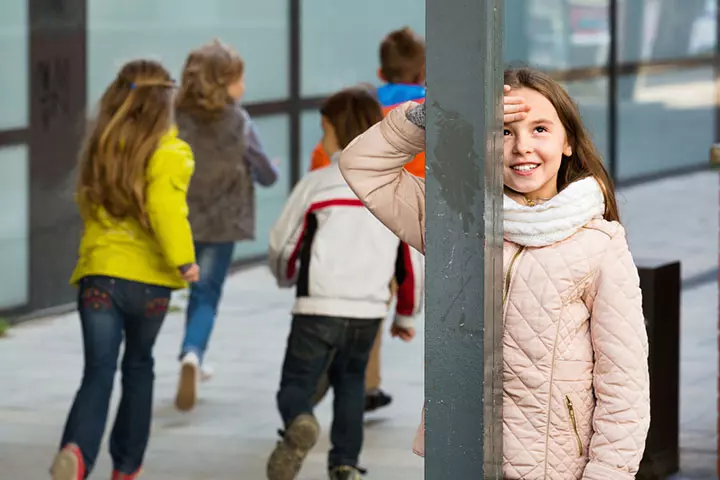
Seek and Find is a fun and interactive team-building game for kids that is ideal for indoor play.
How it helps:
The game helps kids learn the importance of working together and improves their observation skills and ability to communicate and coordinate.
Materials:
- A safe indoor space.
- Various objects suitable for the kids’ age group.
Number of Participants:
5 or more
Time Required: 10-15 minutes
Instructions:
- Divide the kids into groups of three to five.
- Pick one person from each group to be the ‘finder.’ The finder leaves the room.
- The rest of the group hides an object in the room.
- The finder comes back in and starts looking for the object. Others give clues by saying ‘hot’ when the finder is close to the object and ‘cold’ when they are far away.
- The finder uses the clues to locate the hidden object. The group continues to help until the object is found.
Tips to the facilitator:
Instead of verbal cues, applause can also be used. Use soft claps when the finder is far and loud claps when they are close.
17. Build A Bridge
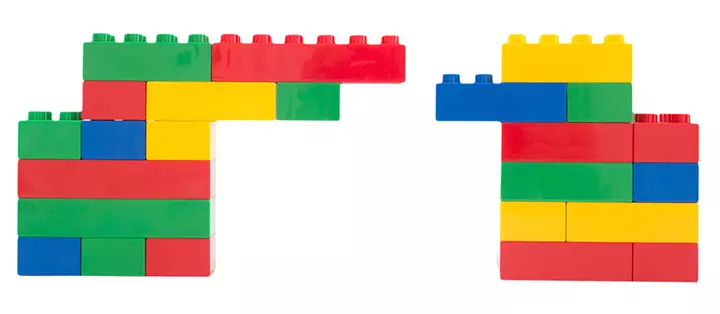
Build A Bridge is a slightly complex team building activity that is ideal for middle and high school kids.
How it helps:
These creative activities teach kids how to communicate clearly and effectively while enabling them to solve problems in a fun way.
Materials:
- Newspapers
- Masking tape
- Straws or craft sticks
- Plastic pipe or tubes
You could also use a Lego set for the activity.
You should conduct indoor activities with a lot of space where the kids can work.
Number of participants: Eight (even number)
Time required: 45 minutes
Instructions:
- Divide the group into two teams of four each.
- Give each team the material to make the bridge.
- Each team has to make half of the bridge and connect them and complete the design. The trick is to do it without looking at what the other is doing.
- The teams have to rely on their communication skills to try to make identical halves that can be joined.
Tips to the facilitator:
You can ask the teams to choose from simple designs for starters.
18. Balloon Questionnaire

This icebreaker activity mixes fun with getting to know each other. Including fun and lighthearted questions helps children shed their inhibitions and encourages interaction and bonding. This is best carried out in an indoor setting.
How it helps:
Balloon activity boosts teamwork and communication in an enjoyable way.
Materials:
- Balloons (one per child)
- Slips of paper
- Pens or markers
- An open space for tossing balloons
- A seating area for sharing
Number of participants:
5 or more
Time required: 15-30 minutes
Instructions:
- Give each child a balloon and a slip of paper.
- Ask the children to write a question on their paper. The question can be simple, like ‘Where do you live?’ or more imaginative, like ‘What superpower do you want?’
- Have them put their questions inside the balloons, blow them up, and tie them.
- Once all balloons are ready, gather the kids in an open area.
- On your signal, let them toss and bat the balloons around for a couple of minutes.
- After a while, tell them to stop and pick up one balloon each.
- Have them sit in a circle and start the sharing session.
- One by one, let each child pop their balloon, take out the question, read it to the group, and answer it.
Tips to the facilitator:
Encourage all kids to participate and share their answers, promoting communication and interaction.
19. Zoom
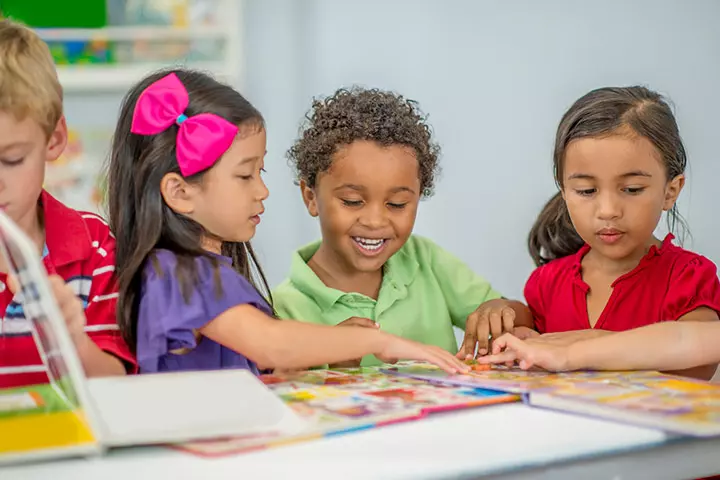
This is a simple activity about developing a story.
How it helps:
This activity enables the kids to use logical skills to complete a short story.
Materials:
- Images that depict a story – you can take comic strips from newspapers or magazines.
- The activity should be conducted indoors, with space where the kids can work.
Number of participants:
10 to 12
Time required: 15 minutes
Instructions:
- Each player gets an image that is a part of a story.
- The kids should not show or discuss the images with the others.
- Once everyone has their own image, they have to come together and put them in the right order to finish the story.
Tips to the facilitator:
Pick a story that does not go beyond 12 or 15 images. You can also make this a competitive activity.
20. Snake Train

Snake Train is a fun indoor activity for building trust among kids. In this game, blindfolded players find objects, relying solely on non-verbal cues.
How it helps:
This activity fosters teamwork and communication skills in an interactive way.
Materials:
- Soft objects such as stuffed animals or cushions
- Blindfolds
- Bucket
Number of participants:
6 or more
Time required: 15- 30 minutes
Instructions:
- Ask the children to form a line and place their hands on the shoulders of the person in front.
- Pick one child to be the guide. They won’t wear a blindfold and will stand at the end of the line.
- Blindfold the other players.
- Scatter the soft objects on the floor within a set area.
- The guide, without talking, leads the blindfolded players to find and pick up the objects.
- After picking up the object, the guide should direct the player to place it in the bucket.
- Make sure everyone keeps their hands on the shoulders of the person in front throughout the game.
- Keep rotating the roles so everyone gets a turn to be the guide.
Tips to the facilitator:
Ensure the area is safe and free of obstacles.
You can also make this a competitive activity.
21. Bus Stop

This is a cool icebreaker that helps kids to know each other better. This team bonding activity can be conducted indoors or outdoors.
How it helps:
It enables the children to express their opinion freely and accept that others do not necessarily share the same views. It also helps build their decision-making skills.
Materials:
- 2 ropes
- Space to play, without obstacles
Number of participants:
10 to 12
Time required: 20 minutes
Instructions:
- The kids will have to stand in between two ropes on either side – these ropes act as the buses.
- The kids have to stand in a line facing the instructor.
- The facilitator will read a word pair, like day/night, book/TV, walk/run, listen/talk, cat/dog, etc.
- Kids have to jump to the bus on the left if they associate most with the first word in the pair, or the right bus if they associate with the second word.
- They have to make a choice of which bus they will board in less than two seconds after the word pair is read aloud.
Tips to the facilitator:
Prepare the setting ahead – place the ropes at an equal distance from where the kids stand.
22. Cup Grab Challenge
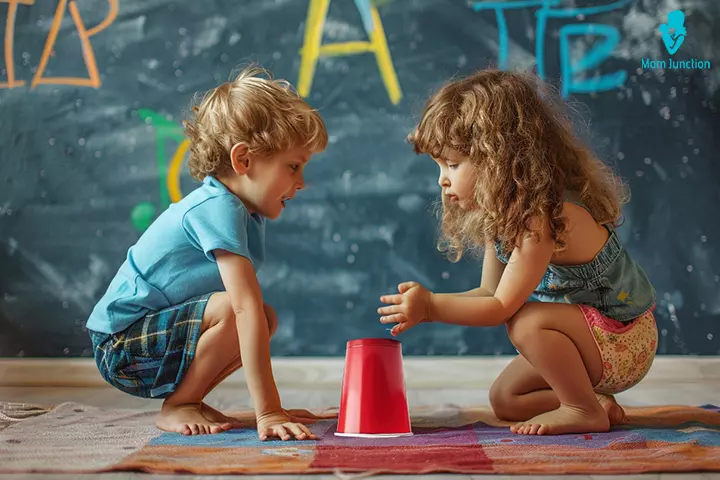
The Cup Grab Challenge gets kids moving and thinking fast. It can be played indoors or outdoors and encourages teamwork.
How it helps:
This activity may help sharpen the children’s reflexes, and boost coordination, listening, and teamwork skills.
Materials:
- Plastic cups
- Open space for movement
Number of participants:
Minimum 2
Time required: 5 minutes for each round
Instructions:
- Split the kids into pairs. They should face each other while squatting with a plastic cup placed between them.
- Choose a child as the leader. They’ll call out body parts like ‘head,’ ‘knees,’ ‘toes,’ and so on.
- Whenever the leader calls out a body part, players must quickly touch that part on their own bodies.
- When the leader shouts ‘Cup!’, both players should try to snatch the cup from the ground.
- The player who grabs the cup stays in the game, the other player is out for that round.
- If a player touches the cup when ‘Cup!’ was not called, they are out for that round.
- Keep playing with different pairs until everyone has had a turn.
Tips to the facilitator:
Make the game more challenging by changing the speed of the leader’s calls.
23. Coin Logo

This is a creative team-building activity for all ages. The activity is best conducted indoors.
How it helps:
The activity encourages brainstorming to come up with a commonly accepted idea or design.
Materials:
- Coins
- Paper
- Pencil
Number of participants:
9 to 12
Time required: 30 minutes
Instructions:
- In a bag, put different types of coins and ask each kid to pick one coin.
- Create groups of three and tell the kids to use their coins as inspiration to come up with ideas for their own coin logo.
- The kids have to design a logo in 20 minutes and then explain what the logo stands for.
Tips to the facilitator:
Ensure you have coins of different denominations, if possible from different countries, for this activity.
24. A Spider’s Web
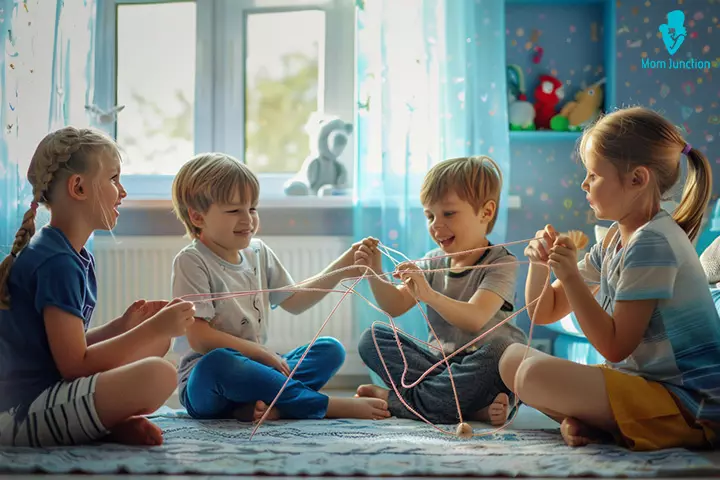
This fun activity can be carried out both indoors and outdoors. At the end of the game, each and every participant will be connected to each other through a cool web pattern
How it helps:
This group game for kids brings students closer together while celebrating their differences.
Material:
- A big ball of string
- Space for everyone to stand or sit in a circle
Number of participants:
10 or more
Time required: 15 minutes
Instructions:
- Get everyone in a circle with some space between them.
- Tell everyone that the aim is to make a ‘spiderweb’ by connecting everyone with the string.
- The person holding the string starts by sharing a funny or silly story about themselves.
- After sharing their story, they keep hold of the string and toss the ball to someone else in the circle.
- Each person who catches the ball of string shares their own story before tossing it to someone else.
- As the game goes on, the string makes a web pattern, linking everyone together.
Tips to the facilitator:
Keep an eye on the string to make sure it’s passed around safely.
25. Night Trail
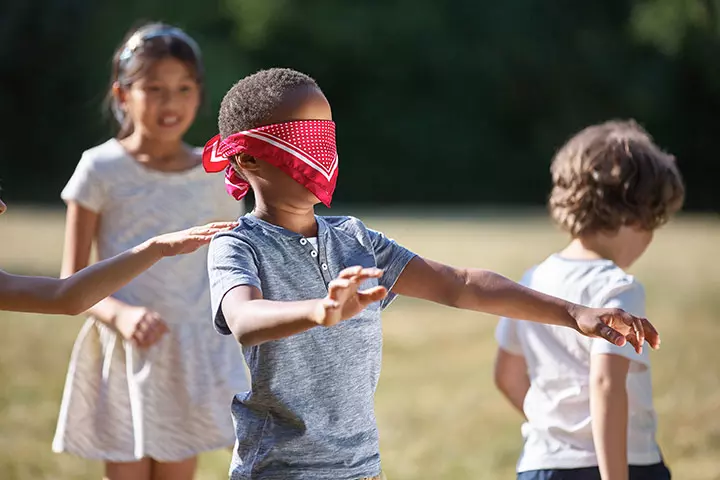
This is a fun activity with lessons in communication, trust-building, and cooperation. This activity can be conducted indoors or outdoors.
How it helps:
The activity teaches kids to learn to trust and support one another in a team. Cooperation, awareness of risk, and sensory perception are also at play in this activity.
Materials:
- Blindfolds
- Course obstacles – Kid-friendly options like soft tires, cargo nets, blocks for kids
- Soft floor mats
Number of participants:
15
Time required: 30 minutes
Instructions:
- Divide the group into teams of five.
- Blindfold one participant from each group.
- The rest of the team should take turns to instruct their team member to navigate through the obstacle course and reach the finish line.
- The activity can be repeated with each player taking a turn at the course.
Tips to the facilitator:
Prepare the setting beforehand – create a mini obstacle course for the kids inside the room. You can also set it up outdoors, but make sure it is safe for kids.
26. Hula-Hoop Tic-Tac-Toe
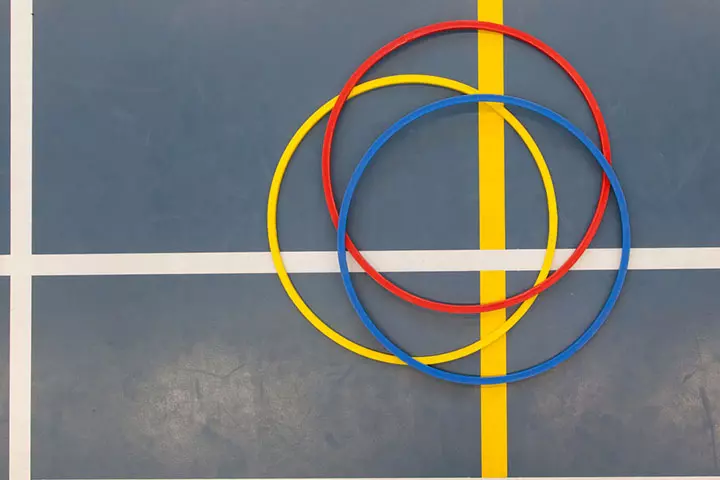
Hula-Hoop Tic-Tac-Toe is a fun activity where hula hoops are used to create a tic-tac-toe grid. This game is best played indoors and combines the excitement of a race with the classic game of tic-tac-toe, making it enjoyable for kids.
How it helps:
This physical activity promotes teamwork, coordination, and quick thinking.
Materials:
- Hula-hoops
- Bean bags
- Open space
Number of participants:
10 or more
Time required: 15-30 minutes
Instructions:
- Arrange the hula-hoops in a tic-tac-toe grid. Leave enough space for easy movement.
- Divide the kids into teams with equal numbers.
- Explain the rules. Each team will take turns sending one player to place a bean bag in a hula-hoop. After placing the bean bag, the player runs back to tag the next teammate.
- The first team to get three bean bags in a row (horizontally, vertically, or diagonally) wins.
- The game continues with players from each team taking turns until a team wins by forming a tic-tac-toe line.
Tips to the facilitator:
Monitor the game to ensure fair play and keep the energy high by cheering on all teams.
27. The Great Egg Drop
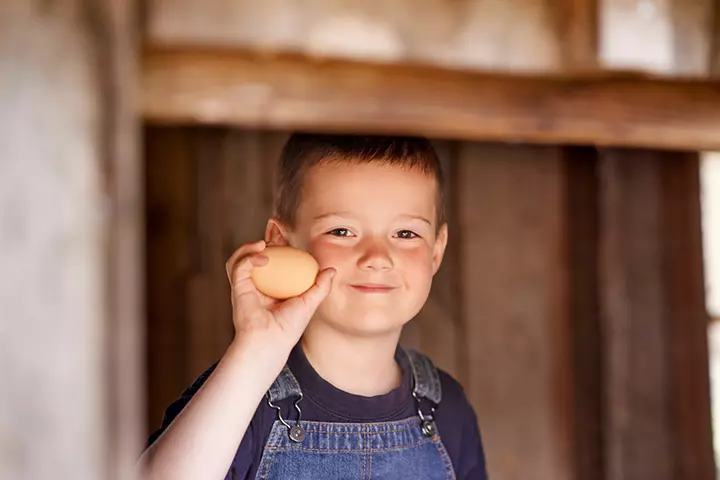
If you do not mind the kids getting a little messy to learn how to work in teams, this team building activity should be tried. This activity can be conducted indoors or outdoors.
How it helps:
It helps in problem solving – trying different solutions to find the best deal. It encourages kids to think out of the box.
Materials:
Soft, thick fabric, newspapers, cardboard boxes, thermocol, bubble wrap, baskets and other material to build an egg package that can sustain a drop from a height of six feet.
Number of participants: 8 to 16
Time required: 2 hours
Instructions:
- Divide kids into teams of four each and give each team the material to build a package.
- Let them work for 30 minutes to come up with a package that prevents the egg from breaking. In the end, each team will demonstrate the egg drop using the packages they have made and explain how they have succeeded.
Tips to the facilitator:
You may need to have enough eggs for the activity, should the packages fail the first time.
28. Guessing Game

It is a no-mess, super-fun verbal guessing game that children may enjoy playing. It involves guessing the word written on a piece of paper based on clues and hints provided by others.
How it helps:
This activity helps sharpen the children’s communication and observation skills.
Materials:
- Pieces of paper
- Pens or markers
- Sticky notes or tape
Number of participants:
6 or more
Time Required: 5-10 minutes
Instructions:
- Have each child choose an object, place, animal, or bird and write its name on a small piece of paper or sticky note.
- Without showing the word to anyone else, they stick it on another player’s forehead.
- Players take turns giving hints to help the person with the paper on their forehead guess the word.
- The player with the paper guesses the word with a limited number of tries.
- Once a player either guesses correctly or gives up, the next player takes a turn.
Tips to the facilitator:
To make the game more exciting and educational, try themed rounds like famous characters, movie titles, or historical figures.
29. Circle Of Silence

This is a cool activity where players get to sharpen their listening skills and strategize to achieve a common goal. This activity can be conducted indoors or outdoors.
How it helps:
The activity encourages creative thinking and interpersonal communication without a lot of noise.
Materials:
- A container – metal or plastic
- Marbles
- Blindfold
- Space to play
Number of participants:
Eight to ten
Time required: 30 minutes
Instructions:
- Pick one person from the group to be ‘It’.
- The other players form a circle facing each other and ‘It’ stands in the center.
- The players in the circle should slowly pass a tin box around the circle, without letting the marbles make any noise.
- If the object being passed around makes a noise, and It can point out where the noise is coming from, then he or she points in that direction.
- If ‘It’ gets the answer right, the person who held the tin when it made noise becomes ‘It’.
- Each time, kids can come up with ways to prevent the object from making noise.
- The activity can be played for as long as the kids are having fun.
Tips to the facilitator:
The best materials for this activity would be a tin cup and a few marbles – enough so they can move freely inside the cup.
30. Scavenger Hunt

Scavenger hunt is an adventure-filled activity that the children love as they get to explore and find hidden items, making the game exciting.
How it helps:
This activity helps kids develop problem-solving skills as they plan and find their way through the hunt. It also encourages outdoor exploration and may help in instilling a love for nature.
Materials:
- List of items to be found.
- Time notebooks and pens for each team to record their findings.
Number of participants:
Minimum 6
Time required: 15-30 minutes
Instructions:
- Split the kids into two groups containing an equal number of participants.
- Provide each team with a list of items they need to find.
- Set a time limit for the hunt.
- Once the time is up, call out the kids and tally the results.
- Declare which group wins the run based on the number of items found.
Tips to the facilitator:
Create a list of items to be found based on the age and interests of the participants to keep them engaged and motivated.
31. Human Shapes
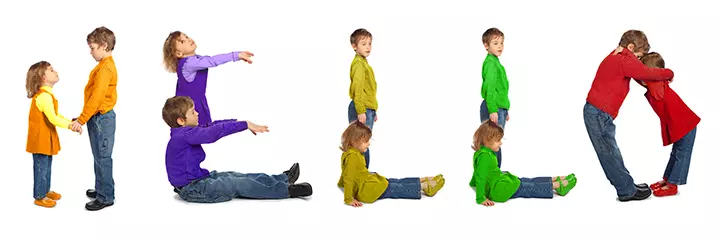
Human Shapes is a fun and creative exercise that encourages kids to work with each other physically and intellectually.
How it helps:
This activity encourages creative thinking and also allows them to use the given space in a smart way.
Materials:
- Soft mats or blanket
- Space for activity
This activity can be conducted indoors or outdoors (on clean grass or surface) but without any obstacles.
Number of participants: 10 to 15
Time required: 20 minutes
Instructions:
This is a small group activity and can be played by the entire group together, or by smaller subsets of the group.
- Ask the participants to spread out in the area.
- Start with individual letters like B, C, T, etc., and ask the participants to form them using their bodies. Two or more kids can come together to form one letter if needed.
- Then, the instructor gives the team a word – it should be at least six letters long.
- Ask the participants to quickly form letters of the word using their bodies. They can try forming the letters by standing or they can lie down on the ground – it is up to them to decide.
- The objective is for the kids to make use of nothing else but their bodies to form the letters of the word.
- This could also be a competition between teams if you have a very large group and area.
Tips to the facilitator:
Kids may lie down on the floor to form shapes that they cannot make while standing. Make sure that the space you choose for the activity is free from dirt and any obstacles that can be harmful to the kids.
32. Over Under Relay

The Over Under Relay is a lively team activity for kids that promotes cooperation. It can be played both outdoors and indoors.
How it helps:
Encourages children to think quickly and also helps in improving their focus and accuracy in completing tasks.
Materials:
- A softball or similar object that is suitable for passing.
- A clear space for participants to line up and move freely.
Number of Participants:
5 or more
Instructions:
- Ask the children to form a line, facing the same direction, with a designated starting line and endpoint.
- The first child in line is given a ball, which they pass over their head to the next child. The second child then passes the ball under their legs to the person behind them.
- The ball continues to be passed alternately over and under until it reaches the last child in line.
- Once the ball reaches the end, the last child moves to the front of the line, and the process begins again.
Tips to the facilitator:
Start slowly and increase the pace as the children become more comfortable.
33. All Aboard
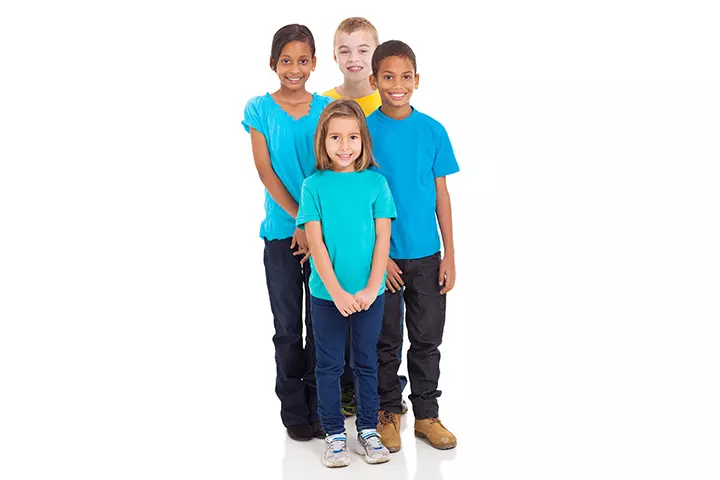
All Aboard is an activity that will encourage kids to make the most of the space available, without leaving anyone or anything out. This activity is best conducted indoors.
How it helps:
This activity improves the child’s spatial sense, goal setting, leadership, and problem-solving skills.
Materials:
- A piece of chalk and a tarpaulin or rope
- Space
Number of participants:
8 to 15 (depending on the space available)
Time required: 20 minutes
Instructions:
- Make a big circle using a piece of chalk or rope. You could also choose another geometric shape like a square if you want. You can also use the tarpaulin to determine the area of the circle or square.
- Ask the kids to stand inside the circle – luggage and all. The aim is to ensure that everyone is ‘aboard’.
- If the kids are successful, reduce the size of the circle or square and ask them to readjust themselves so that everyone is inside.
- Do this as many times as you can, until the kids cannot fit inside the circle anymore.
Tips to the facilitator:
Make sure that you clearly demark the space that the kids have to occupy.
34. Blanket Switch

Blanket Switch is an engaging indoor team-building activity where teams work together to flip over a blanket without stepping off it.
How it helps:
This activity helps kids work together to solve a common problem and also improve their coordination.
Materials:
- Three large blankets
- Space large enough for seamlessly carrying out the activity.
Number of participants:
12 or more
Time required: 15 minutes
Instructions:
- Divide the participants into three teams and assign a blanket to each team.
- Have each team stand on their respective blanket, leaving approximately a quarter of the space unoccupied.
- Explain to the teams that their task is to collectively flip the blanket over without anyone stepping off it.
- Once the teams have successfully flipped the blanket, they should end up standing on the other side together.
Tips to the facilitator:
Once a team successfully flips their blanket, celebrate their achievement and encourage them to share what strategies worked for them.
35. Life Highlights

Life Highlights is an ice breaker activity that can bring the members of a team closer. This activity is best conducted indoors.
How it helps:
This activity enables children to talk about their memories openly, encourages them to put their experience in words, recall specific moments, and analyze.
Materials:
- Space for the activity
Number of participants:
8 to 12
Time required: 30 minutes
Instructions:
- Ask all the participants to close their eyes and think about some of the happy, good memories in their life. It could be something with their family, friends, or anyone in their life. Give them a minute to be ready.
- Ask them to keep their eyes closed and narrow down the highlights of their memories – what they think were the best ones.
- Give each child 30 seconds to talk about one of their best memories and explain why they think it is best.
- The first part of the activity allows the children to think about their life. The second part, which is called the review, lets their friends know them better.
Tips to the facilitator:
This is a simple activity that enables children to interact with each other, which is important if they have to work with each other.
36. Blindfolded Minefield

For an engaging and interactive team-building activity, consider setting up a Blindfolded Minefield in your classroom or indoor space. This is one of the most effective team building activities for kids as it teaches both teamwork and spatial awareness.
How it helps:
This activity helps kids build communication, trust, and teamwork while having fun and facing challenges.
Materials Needed:
- Tape
- Plastic cones or cups
Number of participants:
Minimum 2
Time Required: 10 minutes
Instructions:
- Define a square area in your classroom using tape. This square will represent the minefield.
- Scatter plastic cones or cups randomly within the square area to create the mines.
- Divide the kids into pairs. One child will be blindfolded and the other will act as their guide.
- The goal of the blindfolded child is to pass the minefield following the instructions of his/her partner without knocking down or touching any of the cups.
- The guide must provide clear and accurate instructions so their partner can make it through the minefield safely while blindfolded.
Tips to the facilitator:
Rotate roles within each pair to give everyone a chance to experience being blindfolded and giving instructions.
37. Dragon’s Den
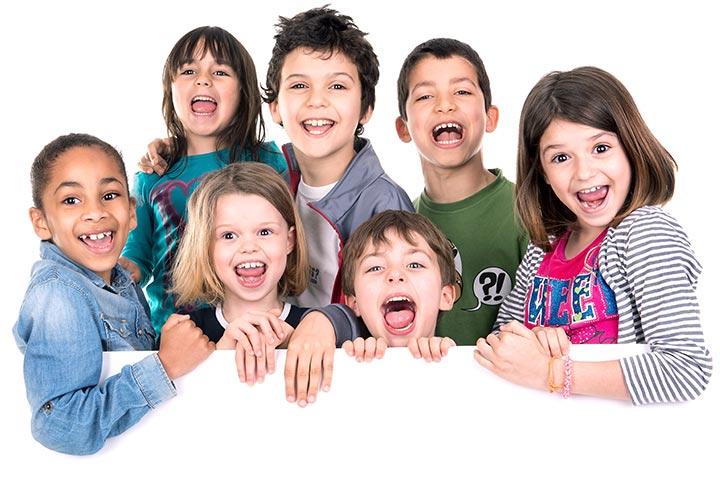
The activity requires the participants to come up with creative ideas to present to the Dragon – the teacher, parent, or the host. The activity is best conducted indoors, particularly in classrooms.
How it helps:
Dragon’s Den inspires creative thinking, encourages them to come up with the best ideas, and boosts healthy competition as well.
Materials:
- Chart paper
- Pencils
- Markers
- Other presentation material that the kids need
Number of participants:
8 to12
Time required: 1 hour
Instructions:
- Divide the group into teams of three or four.
- The kids should come up with an innovative product that they think can make the world a better place.
- In their presentation, they have to come up with information about
- Name of the product
- What does the product do?
- How will it make the world a better place?
- Name of their company
- Cost of the product
- Once they have the information ad design ready, they can present it at the Dragon’s Den.
Tips to the facilitator:
When conducting this activity for kids, you can use variations for the theme – it can be a drawing or picture or a story or short play that the kids can make and present. The idea here is not to test their business acumen, but to encourage their creativity.
38. Gaze Lock

Gaze Lock is an engaging trust-building activity designed to enhance eye contact and foster connections among kids.
How it helps:
Encourages children to build trust and connection with their peers. Enhances the skill of maintaining eye contact, a crucial aspect of effective communication.
Materials: None required.
Number of participants: At least two.
Time required: Approximately 60 seconds per pair.
Instructions:
- Ask the children to pair up, facing each other at a comfortable distance.
- For 60 seconds, encourage them to maintain uninterrupted eye contact.
- After 60 seconds, let them switch partners and repeat the process.
Tips to the facilitator:
Emphasize the importance of respecting their partner’s boundaries during the activity.
39. Musical Chair
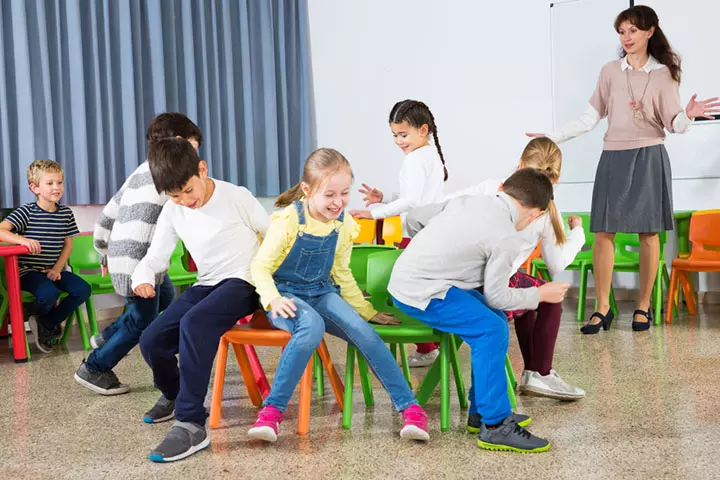
Musical Chairs is a timeless game where kids compete for a limited number of chairs. It can be played both indoors and outdoors.
How it helps:
This is an interesting activity for kids that helps children think quickly and adapt.
Materials:
- Chairs
- Music player
Number of participants:
6 to 10
Time required: 10-20 minutes
Instructions:
- Arrange the chairs in a circle with the seats facing outward. The number of chairs used should be one less than the number of participants.
- Start the music and have the kids walk around the chairs.
- When the music stops, each child must find a chair to sit on.
- Remove one chair after each round. Continue until only one player is left with a chair.
Tips to the facilitator:
Encourage fair play and remind kids to be careful and safe as they move around the chairs.
40. Dream Car
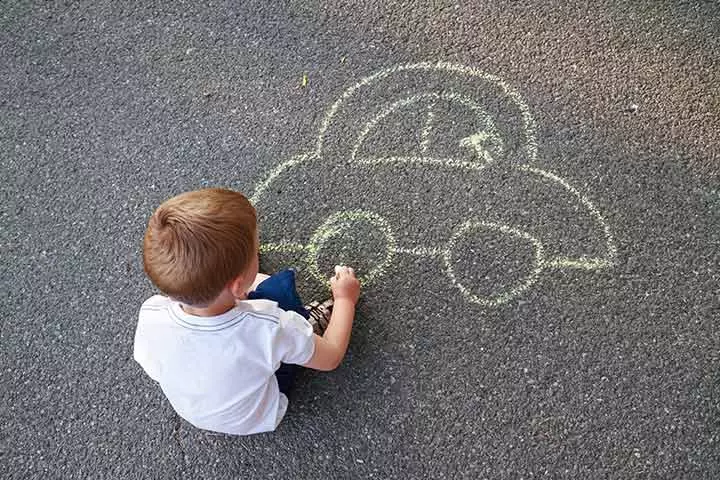
Get the kids to collaborate and design their dream car. Every kid may have his or her own ideas of a car, the trick is to see how they can combine them all and come up with a model that everyone is happy with. This activity is best conducted indoors.
How it helps:
Dream car teaches the children about collaboration, adjustments, or compromise – making space for another person’s ideas, creative thinking, and implementation.
Materials:
- Pencils
- Chart Papers
- Markers
Number of participants:
12 to15
Time required: 1 hour
Instructions:
- Divide the group of kids into teams of two or three.
- Give each team a chart paper, a few pencils, and markers. Give them some extra sheets or paper to draw the designs.
- Ask each team to draw a specific part of the car – the trunk, engine, hood, doors, windows, bumper, headlights, seats, etc. Make sure that they draw and then cut out specific parts that can be joined to make a car.
- Ask all the kids to bring the chart paper cut outs to the center of the room and build a car with them.
- The activity can be a lot of fun, or chaotic, depending on how the kids work with each other in the team.
Tips to the facilitator:
Make sure you try this out yourself first – draw specific parts of the car – make cut outs and see if you can design a car out of them. If yes, use the same list of parts to help the kids make their dream car using chart paper cutouts.
41. Animal Charades
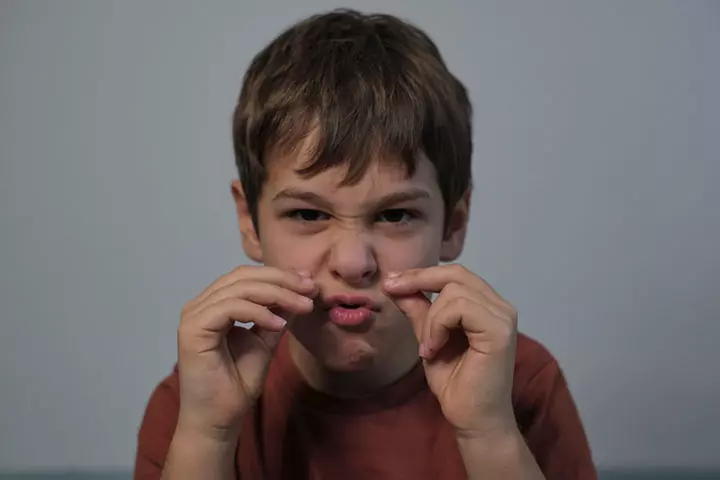
Animal Charades is a fun guessing game where players act like different animals, and their teammates try to guess which animal they are.
How it helps:
Improves communication, creativity, and teamwork as kids mimic animal behaviors using gestures and expressions.
Materials:
- Small pieces of paper
- A small jar
Number of participants
: 4 to 8
Time required: 10-15 minutes
Instructions:
- Write down various animal names on slips of paper and put them in a container or jar.
- Split players into two teams.
- Select one player from each team to be the actor.
- The actor picks a slip of paper and acts out the animal’s behavior without speaking.
- The teammates try to guess the animal within a time limit.
- Teams take turns acting and guessing until all slips have been used.
Tips to the facilitator:
If a child chooses a difficult animal to guess, let the guessers ask ‘yes or no’ questions to help figure it out.
42. Tug of War

Tug of War is a classic team-building activity that is best played outdoors.
How it helps:
Fosters teamwork, communication, and determination as kids work together to pull their opponents across a designated line.
Materials:
- Rope
Number of participants:
12 or more
Time required: 10-20 minutes
Instructions:
- Divide kids into two teams and have them stand on opposite sides of a designated line.
- Each team holds one end of the rope, and on the signal, they start pulling, aiming to pull their opponents across the line.
- The team that pulls their opponents across the line wins.
Tips to the facilitator:
Ensure the rope is sturdy and securely anchored to prevent injuries during the game.
43. Hula Hoop Pass
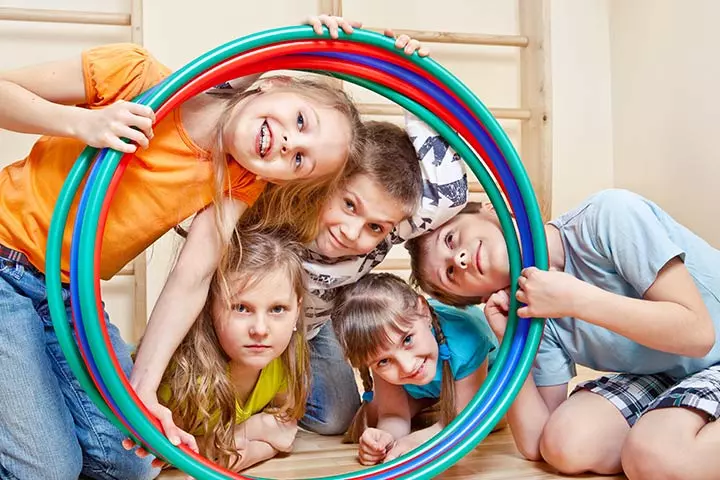
This is a fun activity that kids will enjoy playing. This activity can be conducted indoors or outdoors.
How it helps:
Kids can work on improving their listening, coordinating, strategizing, and implementing skills through this activity.
Materials:
- A hula hoop
- Space for kids to play
Number of participants:
Eight to ten
Time required: 30 minutes
Instructions:
- Ask the kids to form a big circle.
- Place the hula hoop on one kid’s arm and then ask him to join hands with the neighbor to close the circle.
- Now, the child with the hula hoop has to find a way pass on the hula hoop to the next person, without letting go of the next person’s hands.
- The goal is to pass the hula hoop around the circle and bring it back to where it started.
Tips to the facilitator:
This is a fun activity that can be replicated for younger or older kids, or even adults.
44. Paper Airplane Challenge

The Paper Airplane Challenge tasks teams with designing and building paper airplanes that can fly the farthest distance or perform the best aerobatic maneuvers.
How it helps:
Fosters creativity, problem-solving, and experimentation as kids design and test different paper airplane designs.
Materials:
- Paper
- Tape
- Colors to decorate the plane
- Open space
- Measuring tape
Number of participants:
6 or more
Time required: 15-30 minutes
Instructions:
- Provide each team with a standard sheet of paper.
- Ask children to create paper airplanes using any techniques they choose.
- After construction, have teams take turns flying their airplanes and measure the distance or judge the aerobatic performance.
- Award points for distance, accuracy, and creativity.
Tips to the facilitator:
You can show how to fold a paper airplane before starting the activity to help the kids understand the process. Also, colored papers can be used to differentiate between the teams.
45. Marshmallow Castle Challenge

The Marshmallow Castle Challenge tasks teams with building the tallest freestanding castle using only marshmallows and spaghetti noodles or toothpicks.
How it helps:
Promotes creativity, problem-solving, and collaboration skills as kids experiment with different construction techniques.
Materials:
- Marshmallows
- Spaghetti noodles or toothpicks
- Measuring tape
Number of participants:
6 or more
Time required: 10-20 minutes
Instructions:
- Provide each team with a limited number of marshmallows and spaghetti noodles.
- Challenge teams to construct the tallest castle within a specified time frame.
- After the time is up, measure each castle’s height and stability to determine the winner.
Tips to the facilitator:
Encourage teams to test their castle’s stability as they build and make adjustments as needed to prevent it from collapsing.
46. Human knot
This is an excellent bonding activity that can bring all the players together. It demands the participation of all players to make strategized moves. This activity can be played indoors and outdoors.
How it helps:
- This activity can improve children’s listening, coordination, and strategizing skills.
Materials:
- Space for children to play
Number of participants:
Minimum six
Time required: 30 minutes
Instructions:
- Ask the children to stand in a circle and raise their arms.
- They must link their right hands with teammates standing across the circle, not the person adjacent to them and repeat the same for the left hands. However, they should not connect their both hands with the same person.
- Players aim to untangle the knot by stepping over, under, or through the linked hands.
- One person should run the game and “cut the rope” at two places (that allows two players to drop their hands).
- Players should make the maximum effort to untie the knot.
Frequently Asked Questions
1. What age group is suitable for participating in team-building activities?
There is no specific age group suitable for playing team-building activities. Children can play these games whenever they are old enough to understand their rules.
2. How long should team-building activities for kids last?
The duration of a team-building activity depends upon its complexity and the number of players involved in the game. However, most of these activities last 15 to 30 minutes.
3. What are some safety measures to be taken while conducting team-building activities for kids?
When playing outdoors, children are likely to get hurt. Keep a first-aid kit handy. Also, ensure there are more adults to supervise a large number of children. When playing indoors, ensure there are no sharp objects that can harm the children. Also, there should not be objects that can become choking hazards.
4. Is it important for adults to be involved in team-building activities for kids?
Children may not be able to understand the actual purpose of the activity. The presence of an adult will help them better understand the rules and also the purpose and benefits of the team-building activities.
5. What types of team-building activities are suitable for different age groups?
Team-building activities can be adjusted to fit different age groups by modifying their complexity and physical demands. For younger children, simple activities like relay races, scavenger hunts, or fun games that encourage teamwork work well. For teenagers, options like escape rooms, problem-solving challenges, or team sports can help build collaboration and communication skills.
Team building activities for kids help develop and enhance essential life skills such as creative thinking, listening, leadership skills, and problem-solving as a team. It may also promote compassion and boost self-confidence in kids. Group juggling, building a bridge, and just listening are some of the best team-building activities for children. These cooperative games for kids promote interpersonal skills and help children socialize with peers and accept differing opinions. As a result, children learn from each other and understand how to function as a team to achieve goals.
Illustration: Fun Team Building Games And Activities For Kids

Image: Dall·E/MomJunction Design Team
Infographic: Team Building Activities For Children
Besides enhancing their self-esteem, social interactions, and coordination skills, group activities aid children learn about the importance of partnership and togetherness. Here is an infographic documenting interesting and engaging team-building activities for children to have fun and bond with their peers.
Some thing wrong with infographic shortcode. please verify shortcode syntax
Check out this video to learn how to bring your kids together with fun team-building games and activities! Get creative and have a blast with your kids while teaching them important skills.
References
- Research Link/Student Teamwork ASCD.
https://ascd.org/el/articles/-student-teamwork - Building Bonds: The Importance of Team Building for Kids’ Social Development.
https://cisjax.org/importance-of-team-building-for-kids-social-development/ - Team Building Activities.
https://fyi.extension.wisc.edu/wi4hcitizenship/files/2018/04/YACH-Handbook-Ideas.pdf - Learning through play UNICEF.
https://www.unicef.org/sites/default/files/2018-12/UNICEF-Lego-Foundation-Learning-through-Play.pdf - Icebreakers, Energizers, Team-Building, Storytelling, and Warm-up Activities
https://ingenaes.illinois.edu/wp-content/uploads/ING-Activity-Sheet-2016_06-Energizers-and-group-games-Henderson-1.pdf
Community Experiences
Join the conversation and become a part of our nurturing community! Share your stories, experiences, and insights to connect with fellow parents.
Read full bio of Dr. Holly Schiff
Read full bio of Sagari Gongala
Read full bio of Harshita Makvana
Read full bio of Apoorva K





